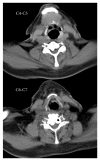Ultrasound-Guided Interscalene Catheter Complicated by Persistent Phrenic Nerve Palsy
- PMID: 29535876
- PMCID: PMC5817254
- DOI: 10.1155/2018/9873621
Ultrasound-Guided Interscalene Catheter Complicated by Persistent Phrenic Nerve Palsy
Abstract
A 76-year-old male presented for reverse total shoulder arthroplasty (TSA) in the beach chair position. A preoperative interscalene nerve catheter was placed under direct ultrasound-guidance utilizing a posterior in-plane approach. On POD 2, the catheter was removed. Three weeks postoperatively, the patient reported worsening dyspnea with a subsequent chest X-ray demonstrating an elevated right hemidiaphragm. Pulmonary function testing revealed worsening deficit from presurgical values consistent with phrenic nerve palsy. The patient decided to continue conservative management and declined further invasive testing or treatment. He was followed for one year postoperatively with moderate improvement of his exertional dyspnea over that period of time. The close proximity of the phrenic nerve to the brachial plexus in combination with its frequent anatomical variation can lead to unintentional mechanical trauma, intraneural injection, or chemical injury during performance of ISB. The only previously identified risk factor for PPNP is cervical degenerative disc disease. Although PPNP has been reported following TSA in the beach chair position without the presence of a nerve block, it is typically presumed as a complication of the interscalene block. Previously published case reports and case series of PPNP complicating ISBs all describe nerve blocks performed with either paresthesia technique or localization with nerve stimulation. We report a case of a patient experiencing PPNP following an ultrasound-guided placement of an interscalene nerve catheter.
Figures
Similar articles
-
Cervical spine disease is a risk factor for persistent phrenic nerve paresis following interscalene nerve block.Reg Anesth Pain Med. 2013 May-Jun;38(3):239-42. doi: 10.1097/AAP.0b013e318289e922. Reg Anesth Pain Med. 2013. PMID: 23518866
-
Case Study of Phrenic Nerve Paralysis: "I Can't Breathe!".J Emerg Med. 2020 Jun;58(6):e237-e241. doi: 10.1016/j.jemermed.2020.03.023. Epub 2020 Apr 27. J Emerg Med. 2020. PMID: 32354588
-
Phrenic nerve block caused by interscalene brachial plexus block: breathing effects of different sites of injection.BMC Anesthesiol. 2016 Jul 29;16(1):45. doi: 10.1186/s12871-016-0218-x. BMC Anesthesiol. 2016. PMID: 27473162 Free PMC article. Clinical Trial.
-
Permanent upper trunk plexopathy after interscalene brachial plexus block.J Clin Monit Comput. 2016 Feb;30(1):51-4. doi: 10.1007/s10877-015-9681-z. Epub 2015 Mar 7. J Clin Monit Comput. 2016. PMID: 25744163
-
Diaphragm-Sparing Nerve Blocks for Shoulder Surgery.Reg Anesth Pain Med. 2017 Jan/Feb;42(1):32-38. doi: 10.1097/AAP.0000000000000529. Reg Anesth Pain Med. 2017. PMID: 27941477 Review.
Cited by
-
Two Cases of Respiratory Insufficiency Secondary to Pre-procedural Nerve Blocks for Upper Extremity Injuries.Cureus. 2021 Dec 19;13(12):e20511. doi: 10.7759/cureus.20511. eCollection 2021 Dec. Cureus. 2021. PMID: 35070548 Free PMC article.
References
-
- Urmey W. F., Talts K. H., Sharrock N. E. One hundred percent incidence of hemidiaphragmatic paresis associated with interscalene brachial plexus anesthesia as diagnosed by ultrasonography. Anesthesia & Analgesia. 1991;72(4):498–503. - PubMed
-
- Prates Júnior A. G., Vasques L. C., Bordoni L. S. Anatomical variations of the phrenic nerve: An actualized review. Journal of Morphological Sciences. 2015;32(1):53–56. doi: 10.4322/jms.070114. - DOI
Publication types
LinkOut - more resources
Full Text Sources
Other Literature Sources
Research Materials





